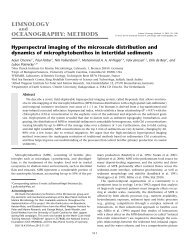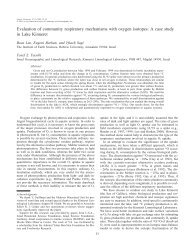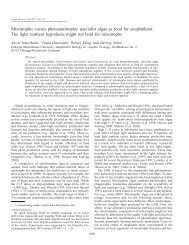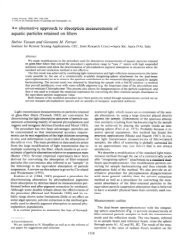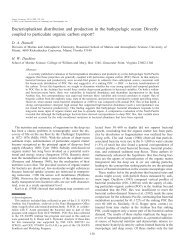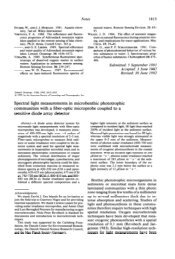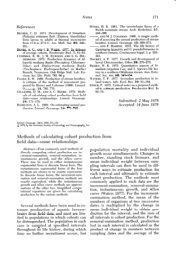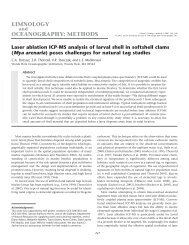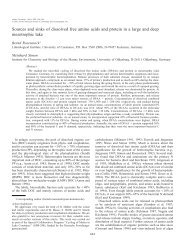Tina van de Flierdt, Katharina Pahnke, and GEOTRACES ... - ASLO
Tina van de Flierdt, Katharina Pahnke, and GEOTRACES ... - ASLO
Tina van de Flierdt, Katharina Pahnke, and GEOTRACES ... - ASLO
You also want an ePaper? Increase the reach of your titles
YUMPU automatically turns print PDFs into web optimized ePapers that Google loves.
<strong>van</strong> <strong>de</strong> <strong>Flierdt</strong> et al. Intercalibration of Seawater Nd Isotopes<br />
54) or Multiple Collector Inductively Coupled Plasma Mass<br />
Spectrometry (MC-ICP-MS: Nu Plasma or Neptune). While historically<br />
TIMS was the method of choice for all laboratories,<br />
the past 15 y have seen a quick rise of MC-ICP-MS as a replacement<br />
for many routine analyses previously performed by<br />
TIMS. Arguments in favor of MC-ICP-MS measurements are<br />
the speediness of data collection achieved by significantly<br />
reduced analysis time, while maintaining a similar precision<br />
to that achieved by TIMS (for a summary on MC-ICP-MS, see<br />
Halliday et al. 2000). The ad<strong>van</strong>tage of TIMS measurements,<br />
especially when consi<strong>de</strong>ring improved ionization during<br />
neodymium oxi<strong>de</strong> measurements (NdO + ) compared with<br />
metal runs (Nd + ), is the ability to return high precision data on<br />
small abundance samples (e.g., Li et al. 2007; Chu et al. 2009;<br />
Harvey <strong>and</strong> Baxter 2009). Extensive literature exists on appropriate<br />
measurement setups, especially on eliminating the relatively<br />
large mass discrimination effect observed for measurements<br />
by MC-ICP-MS (e.g., Vance <strong>and</strong> Thirlwall 2002;<br />
Wombacher <strong>and</strong> Rehkämper 2003) <strong>and</strong> on carrying out the<br />
numerous oxi<strong>de</strong> interference corrections <strong>and</strong> using the appropriate<br />
oxygen isotopic composition during TIMS measurements<br />
(e.g., Thirlwall 1991a, 1991b). Discussing the<br />
<strong>de</strong>tails of applied mass spectrometry between the 15 participating<br />
laboratories goes beyond the scope of this article <strong>and</strong><br />
would violate agreed anonymity. It is, however, important to<br />
note that all laboratories corrected for instrumental mass bias<br />
using a 146 Nd/ 144 Nd of 0.7219 (O’Nions et al. 1977), making<br />
the results directly comparable.<br />
Neodymium isotope measurements in marine particles<br />
The main difference in processing marine particles for their<br />
Nd isotopic composition, compared with seawater samples, is<br />
the initial sample dissolution step. As different digestion <strong>and</strong><br />
leaching methods of filters are likely to result in varying<br />
amounts of REE being removed from the particles on the filters,<br />
two methods were prescribed for the particle samples<br />
from <strong>de</strong>ep waters at BATS <strong>and</strong> shallow water at BATS, respectively.<br />
For the Supor filters (<strong>de</strong>ep water particles at BATS), a<br />
total digest of the filter was targeted by following the method<br />
used by Cullen <strong>and</strong> Sherrell (1999). Briefly, filters were placed<br />
in precleaned Teflon vials together with a mixture of concentrated<br />
HNO 3 <strong>and</strong> concentrated HF (19:1). Complete digestion<br />
of any particles was achieved by refluxing at 120°C for 4 h.<br />
This procedure also leads to a total digestion of the Supor filter,<br />
which however does not constitute a major blank issue<br />
(see “Assessment <strong>and</strong> discussion of results” below). One laboratory<br />
<strong>de</strong>viated from this procedure <strong>and</strong> instead followed a<br />
digestion method adapted from L<strong>and</strong>ing <strong>and</strong> Lewis (1991)<br />
that avoids total digestion of the filter material (Table 5). The<br />
large blank of quartz fiber filters (QMA) in contrast preclu<strong>de</strong>s<br />
total digestion, <strong>and</strong> the approach chosen targets a leaching of<br />
the REE fraction not bound to the silicate phases (Collier <strong>and</strong><br />
Edmond 1984). As <strong>de</strong>scribed in Jean<strong>de</strong>l et al. (1995), samples<br />
were leached in 0.6M HCl at 60°C for 20 h. For the third set of<br />
filters from the Virginia slope station, individual laboratories<br />
239<br />
were free to choose a different method. The only <strong>de</strong>viation<br />
from above outlined methods for samples from the Virginia<br />
slope station was performed however by laboratory number 2,<br />
where QMA filters were leached for 3.5 h at 90°C in a mixture<br />
of 0.005M hydroxylamine hydrochlori<strong>de</strong>, 1.5% acetic acid,<br />
<strong>and</strong> 2 nM EDTA solution (pH of 3.5), with an ultrasonification<br />
step performed every hour.<br />
Rare earth element concentration measurements in seawater<br />
samples<br />
In general, the procedure for <strong>de</strong>termining REE concentrations<br />
on seawater samples can follow a similar methodology<br />
to the one <strong>de</strong>scribed above for the first steps in <strong>de</strong>termining<br />
the Nd isotopic composition. Most laboratories use Fe coprecipitation<br />
or liquid-liquid extraction to preconcentrate the<br />
REE, followed by ion exchange chromatography to separate<br />
the REE fraction from the sample matrix (typically anion<br />
exchange or RE Spec; Table 1b).<br />
The major difference between isotope <strong>and</strong> concentrations<br />
measurements is the smaller water volume required for concentration<br />
analyses (between 4 mL <strong>and</strong> 600 mL; Table 1b), <strong>and</strong><br />
the addition of an isotopically enriched tracer (“spike”) before<br />
preconcentration. This addition is crucial to correct for elemental<br />
fractionation, which may happen during preconcentration<br />
<strong>and</strong>/or ion chromatography. The types of spikes used<br />
for this intercalibration exercise inclu<strong>de</strong> multi-element mixed<br />
REE isotope spikes, two-element isotope spikes, <strong>and</strong> the addition<br />
of monoisotopic elements (Table 1b). Traditionally, REE<br />
concentrations were analyzed by isotope dilution methods<br />
<strong>and</strong> TIMS (e.g., El<strong>de</strong>rfield <strong>and</strong> Greaves 1982), but for this intercalibration,<br />
REE patterns were mostly analyzed by ICP-MS<br />
(Agilent 7500, Element 2, HP-4500, Perkin Elmer Elan DRCII,<br />
Yokogawa PMS-2000). Five laboratories report results for Nd<br />
concentrations only, which in three cases, were <strong>de</strong>termined<br />
on the same large volume sample used for isotopic analyses<br />
through spiking before coprecipitation. In these cases, measurements<br />
were performed by TIMS/MC-ICP-MS.<br />
Notably, one laboratory (nr 1) used the seaFAST system, a<br />
commercially available system (Elemental Scientific) with a<br />
column containing a resin with ethylendiaminetriacetic acid<br />
<strong>and</strong> iminodiacetic acid functional groups to preconcentrate<br />
REEs. This system can be directly connected to an ICP-MS, <strong>and</strong><br />
blanks, st<strong>and</strong>ards, <strong>and</strong> samples are passed through the column<br />
in the same manner, <strong>and</strong> eluted directly into the spray chamber<br />
of the ICP-MS.<br />
Rare earth element concentration measurements in marine<br />
particles<br />
Rare earth element concentrations of marine particles were<br />
attempted by four laboratories. Partial return of data, as well<br />
as some <strong>de</strong>viation from recommen<strong>de</strong>d methodologies, yiel<strong>de</strong>d<br />
a poor statistical basis for assessing the results. We, therefore,<br />
refrain from reporting the actual values in the article, but will<br />
make some qualitative comments on the results in the next<br />
sections to encourage <strong>and</strong> gui<strong>de</strong> future efforts.




